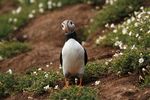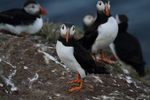Skomer Island Puffin Factsheet - The Wildlife Trust of South and West ...
←
→
Page content transcription
If your browser does not render page correctly, please read the page content below
Skomer Island
Puffin Factsheet
The Puffin is the best-known of the British auks –
its colourful and slightly clown-like appearance
making it immediately recognisable.
The Puffin’s short wings are used for ‘flying’ un-
derwater in search of fish; large wings would be a
disadvantage but small wings make flying in air
rather more difficult and the birds must beat their
wings rapidly to stay aloft. The Puffin’s beak is
only distinctively-coloured in summer; the large
red and grey scutes or horny plates together with
the fleshy yellow rosette in the corner of the mouth
are grown late winter for use in display. After the
breeding season they are moulted, the winter bill
is relatively small and constricted at the base, and
blackish in colour as is the face.
Populations
Formerly much more common in southern Britain, there are now few Puffin colonies south of the Scot-
tish border and those of Skokholm and Skomer are two of the most important. Here the colonies were
once much larger, but the reduced populations of today seem to be more or less holding their own. An
accurate census is difficult, but the best estimates indicate that there may be about 2,000 breeding
pairs on Skokholm and 6,000 on Skomer. On Skomer, the largest concentrations are on the Isthmus
between North and South Haven and at The Wick, but they occur in small numbers along much of the
island’s cliff top.
Nesting
They return to their nesting sites in April,
gradually building up in numbers as the egg
laying season approaches. They nest under-
ground in burrows, not only battling with
each other for these, but also with Manx
Shearwaters since both species use the
same sort of burrows for nesting. Puffins pre-
fer nest-sites close to the cliff-top since the
parent birds can come in quickly and then
escape again to sea, giving the predatory
gulls the minimum chance to attack them.
The Herring and Lesser Black-backed Gulls,
often chase Puffins that are bringing food
back to their chick and try to steal it, but the
Great-backed Gull will kill and eat the adult
www.welshwildlife.org Protecting Wildlife for the FutureSkomer Island
Puffin Factsheet
Breeding & Young
The nest chamber may be many feet underground and is often
lined with bits of dead grass, Sea Campion and Bluebell stems.
In this, the female Puffin lays her single egg, usually in the early
part of May. In size and appearance, the egg closely resembles a
white hen’s egg and is incubated by the parent birds in turn for
about six weeks. The newly-hatched chick weighs about 35-
45grams and looks rather like a darkish-grey powder-puff since
the down is so long that it almost completely covers the small bill
and the legs and feet.
The chick remains in the burrow for about six weeks and reaches
a weight of about 300 grams during this time.
Food
Both parents bring food to the chick; the commonest item is San-
deels which the parents catch by diving. Having caught a Sandeel,
it is held between the tongue and upper mandible, enabling the
bird to catch another, and another. On Skomer, the normal num-
ber of fish carried back to the nest at each visit is about 10, but the
world record is 80 (albeit small larval fish), recorded on an island in northern Norway. Most chicks re-
ceive some five to eight feeds a day, each averaging about eight grams.
Towards the end of July, when the chicks are ready to leave the island, they are still not fully-grown,
being about 70% of the adult’s weight. Unlike the young of Razorbills and Guillemots, they can fly rea-
sonably well at this stage. However, they are still very vulnerable to attacks by predatory gulls, so they
leave at night, working their way down to the cliff-edge and taking off in the darkness. They go by
themselves and are out of sight of land by day-break. Thereafter, they are on their own and receive no
further parental care.
The young Puffin remains at sea for almost two years; almost
no one-year Puffins make land-fall at the nesting colonies.
From the age of two onwards the young birds spend more
and more time at the colony in summer, looking for a mate
and prospecting for a burrow. Although a few may start to
breed at the age of four, most do not do so until they are five.
The breeding success of Puffins is not very high; on average
each pair rears a chick every two years and less than one in
five of these young survive to reach breeding age.
Once they have attained breeding age, they are long-lived birds. In good times, as many as 95% of the
breeding birds may survive to breed the following year (though in recent years on Skomer the survival
has been nearer 85%). A 95% annual survival means that the average expectation of life for a Puffin
that has just started to breed is about 20 years, so that counting the five years of immaturity, the aver-
age life expectancy of Puffins is about 25 years. Some birds live much longer, however, with the cur-
rent record on Skomer more than 38 years!
www.welshwildlife.org Protecting Wildlife for the FutureSkomer Island
Puffin Factsheet
Research
Research on Skokholm and Skomer’s
Puffins has been carried out for many
years. The first studies were carried
out by Ronald Lockley in the 1930’s on
Skokholm. Since then much more has
been undertaken by a variety of ob-
servers, and much of what we know
about the life-history of our Puffins is
derived from their studies.
Watching
Puffins can be seen on Skomer from
April until August, though in early April
they may be here in large numbers on
one day with none the next, until they settle mid-month. Mid-June to mid-July is the time to see really
big numbers, as parents are busy to-ing and fro-ing with food for theiri chicks. Numbers are also
swelled then by birds too young to breed but are prospecting for the future. By the first week in August
only a handful remain, and these are soon to depart, leaving the Puffin colonies deserted again until
the following spring.
If you would like to know more about the Skomer
Puffins, and at the same time support the ongoing
programme of work, then why not Protect-a-Puffin
and adopt one of your very own? Details from the
Wildlife Trust of South & West Wales.
Pictures by Dave Boyle, Chris Taylor and Ben Dean
www.welshwildlife.org Protecting Wildlife for the FutureYou can also read






















































